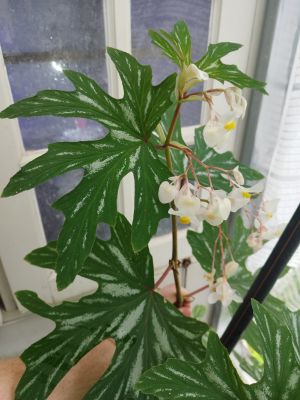Begonia aconitifolia
Species Information
Classification
- Kingdom: Plantae
- Clade: Angiosperms
- Order: Cucurbitales
- Family: Begoniaceae
- Genus: Begonia
- Section: Latistigma
- Species: Begonia aconitifolia
- Authority: Alphonse Pyramus de Candolle (1864)
Distribution
Begonia aconitifolia is native to Brazil, specifically in the Atlantic Forest biome. It thrives in humid, subtropical environments, often found in shaded understories or along forest edges.
Habitat
This species grows in humid, shaded environments typical of the Atlantic Forest, often in well-drained, organic-rich soils. It is adapted to areas with high humidity and moderate light, avoiding direct sunlight.
Characteristics
Begonia aconitifolia is a cane-like begonia that can grow up to 1.5 meters tall. It is notable for developing a caudex (a thickened stem base) as it matures, which is uncommon among cane-like begonias.
- Leaves: Palmately lobed, with a mid-green base color. The leaf blade features silvery-white markings, which can range from sparse streaks to dense clusters, sometimes covering almost the entire leaf except for the veins. Juvenile leaves are light green with a pale pink to reddish tinge. - Stems: Thick, cane-like, and upright, with a woody base as the plant ages.
Flower Details
- Flowers: The species produces panicles of white flowers.
- Male flowers: Have 2 tepals. - Female flowers: Have 5 tepals.
- Blooming season: Typically blooms during the warmer months, from late spring to early autumn.
Etymology
The specific epithet aconitifolia refers to the resemblance of its leaves to those of the genus Aconitum (Monkshood or Wolf's Bane), a temperate plant known for its deeply lobed foliage.
Comparison to Similar Species
Begonia aconitifolia is often compared to Begonia pachypoda (also known as Begonia leathermania), as both species share: - Similar leaf shapes. - A caudex-forming growth habit. - Membership in the Latistigma section.
Superba Hybrids
The Superba hybrids are a group of begonias that often include Begonia aconitifolia as a parent plant. These hybrids are characterized by: - Large, lobed, or deeply cleft leaves. - Robust, cane-like growth. - Diverse leaf patterns and colors.
The first Superba hybrid, Begonia 'Superba Azella', was created in 1926' by Eva Kenworthy Gray, who crossed Begonia aconitifolia with Begonia 'Lucerna'. This marked the beginning of a long lineage of Superba hybrids, many of which retain traits from B. aconitifolia.
Synonyms
- Begonia faureana Garnier
- Begonia faureana var. argentea Linden
- Begonia faureana var. metallica Rodigas
- Begonia kimusiana C.Chev.
- Begonia sceptrum Rodigas
Conservation Status
Begonia aconitifolia has not been evaluated by the IUCN Red List. However, its native habitat in the Atlantic Forest is under threat due to deforestation and habitat fragmentation.
Additional Notes
- Cultivation: Begonia aconitifolia is popular among begonia enthusiasts for its striking foliage and unique growth habit. It prefers bright, indirect light, high humidity, and well-draining soil. - Propagation: Can be propagated through stem cuttings or seeds.
Gallery
- Begoniaaconitifolia leaves.jpg
Leaves showing silvery-white markings
References
1. NParks Flora & Fauna Web: Begonia aconitifolia 2. American Begonia Society: What is a Superba? 3. American Begonia Society: Another Look at B. sceptrum and B. aconitifolia 4. Golding, J., & Wasshausen, D. C. (2002). Begoniaceae. In: Flora of the Venezuelan Guayana.
External Links
- Kew Science: Begonia aconitifolia - American Begonia Society


